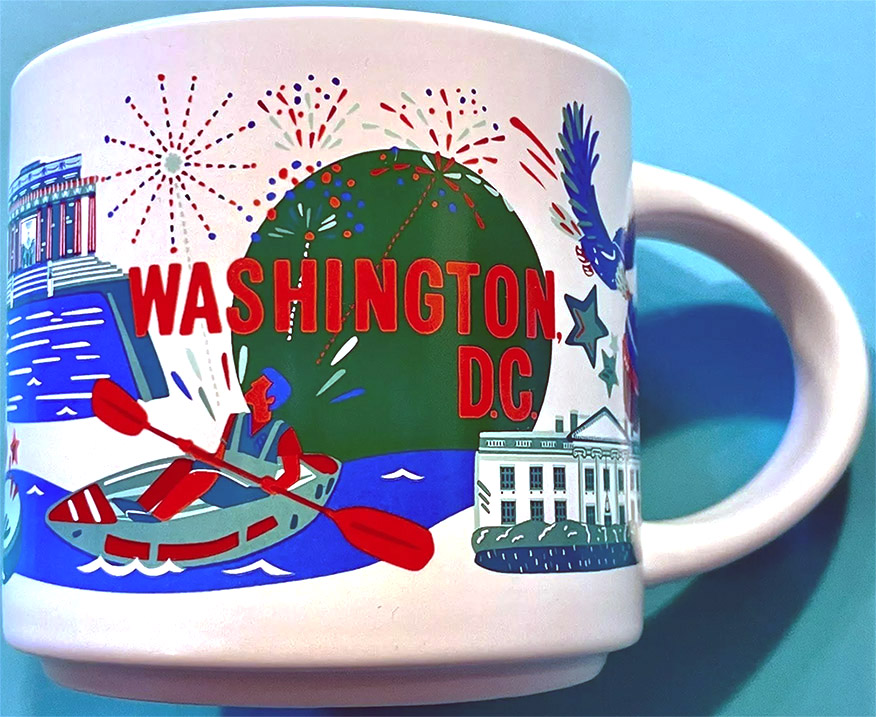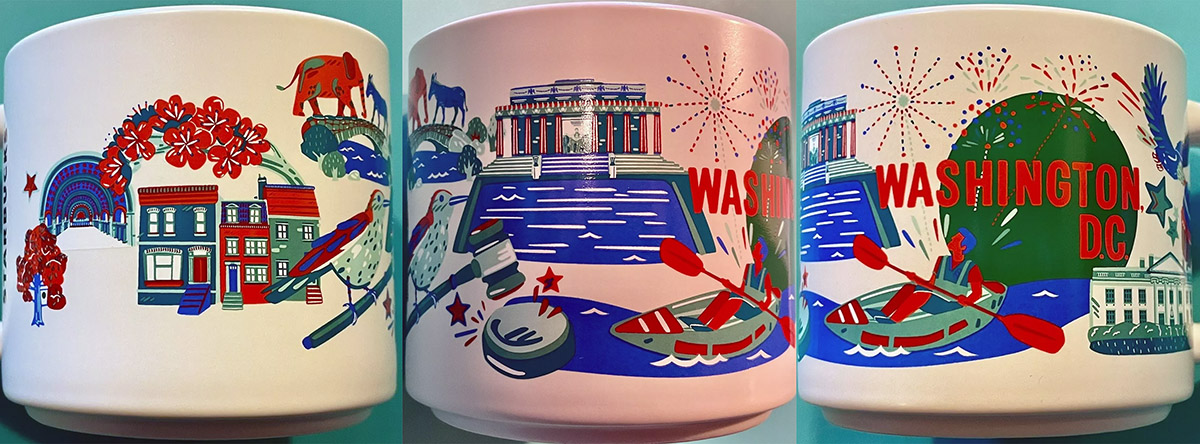
Discovery Series – Washington, D.C.
Starbucks Discovery Series – Washington, D.C., and the ornament that I’ve added already were released together earlier this month. Traditionally, the bigger mug has more elements in the design:
– The Lincoln Memorial, an iconic symbol of American democracy, stands majestically at the western end of the National Mall in Washington, D.C. Dedicated to President Abraham Lincoln, the memorial was designed by architect Henry Bacon and features a striking 19-foot marble statue of Lincoln seated contemplatively. The memorial’s classical Greek temple design, with 36 Doric columns representing the states in the Union at the time of Lincoln’s death, draws millions of visitors annually. Its location offers a sweeping view of the Reflecting Pool and the Washington Monument, making it a poignant tribute to Lincoln’s legacy and a symbol of unity for the nation.
– The Tidal Basin, a man-made inlet adjacent to the Potomac River in Washington, D.C., is famous for its stunning cherry blossoms that bloom each spring. Created in the 19th century as part of the city’s landscaping, the Tidal Basin is surrounded by several iconic landmarks, including the Jefferson Memorial and the Franklin Delano Roosevelt Memorial. Its name comes from the tidal flow of the nearby Potomac River, which fills and empties the basin daily. Beyond its scenic beauty, the Tidal Basin serves as a popular recreational area, offering opportunities for walking, picnicking, and enjoying the serene waterside views of the nation’s capital.
– The District of Columbia’s official bird is the Wood Thrush (Hylocichla mustelina), chosen for its melodious song and its historical presence in the region’s forests. This medium-sized songbird, recognizable by its reddish-brown upperparts and distinctive spotted breast, migrates to the area during spring and summer to breed and raise its young. The Wood Thrush’s ethereal song, often heard in the early morning and evening hours, adds to the city’s natural ambiance despite its urban setting. Designated as the official bird of D.C. in 1967, the Wood Thrush serves as a reminder of the district’s commitment to preserving its natural habitats amidst its bustling metropolitan environment.
– In American politics, the donkey and elephant have become symbols representing the Democratic and Republican parties, respectively. The donkey’s association with the Democratic Party dates back to the 1828 presidential campaign when Andrew Jackson’s opponents called him a “jackass.” Jackson embraced the symbol, turning it into a positive representation of strong-willed leadership. The elephant, adopted by the Republican Party in the late 19th century, symbolizes strength, stability, and intelligence. These enduring symbols are often used in political cartoons, rallies, and media coverage to represent the ideologies and platforms of each party, contributing to the colorful and dynamic nature of American political discourse.
– Georgetown, one of Washington, D.C.’s oldest neighborhoods, offers a blend of historic charm and modern sophistication. Founded in 1751 along the Potomac River, Georgetown became a thriving port town before being incorporated into the District of Columbia in 1871. Today, its cobblestone streets, Federal-style architecture, and vibrant shopping and dining scene attract locals and tourists alike. Georgetown University, founded in 1789, adds to the neighborhood’s academic and cultural richness. With its waterfront parks, historic homes, and renowned landmarks such as the Old Stone House and the Georgetown University campus, Georgetown remains a cherished district within the nation’s capital.
– The Chesapeake and Ohio Canal, often abbreviated as the C&O Canal, is a historic waterway that stretches 184.5 miles from Washington, D.C., to Cumberland, Maryland. Constructed in the 19th century primarily for transporting coal, lumber, and agricultural products, the canal played a crucial role in the region’s economic development. Today, it is a National Historical Park maintained by the National Park Service, offering visitors opportunities for hiking, biking, and exploring its scenic towpath. The canal’s locks, aqueducts, and restored lockhouses provide a glimpse into the past, showcasing the ingenuity and labor that went into constructing and operating this important transportation artery during the early days of the United States.























































































